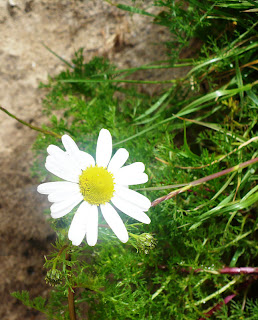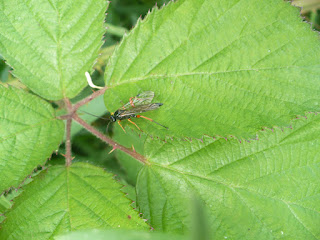This blog may help people explore some of the 'hidden' issues involved in certain media treatments of environmental and scientific issues. Using personal digital images, it's also intended to emphasise seasonal (and other) changes in natural history of the Swansea (South Wales) area. The material should help participants in field-based modules and people generally interested in the natural world. The views are wholly those of the author.
Saturday, 30 June 2012
Wednesday, 27 June 2012
Tuesday, 26 June 2012
The Last Post for George
News that the last Pinta island sub-species of Giant Galapagos tortoise, dubbed 'Lonesome George', has passed away at the age of 100 or more or less -people are not sure how old he was (http://www.guardian.co.uk/environment/2012/jun/25/lonesome-george?INTCMP=SRCH). George, as the last of his kind, was regarded as the rarest of animals but, in essence, the fate of his sub-species was determined long before George's going into his shell for the last time. The miniscule amount of genetic diversity evident, even if he had elected to breed, would have condemned his line and breeding would have involved hybridisation with a related sub-species.
Thursday, 21 June 2012
Wednesday, 20 June 2012
Rio Not So Grand?
The current Environment Conference in Rio, some 20 years after the initial discussions on sustainable development, appear to be a much depleted version of the initial lofty ambition for restricting climate change etc (http://www.uncsd2012.org/). Most of the 'big player' politicians have gone to concurrent meetings on the current economic crisis. This is understandable, as politicians in democracies crave to be elected and one is unlikely to be re-elected if promising declining living standards and an end to 'economic growth'. The sad fact is that one cannot get improvements in material wealth for all in a world where the total population continues to escalate. People with a meaningful vote are not likely to vote for pauperisation of themselves and their families even if this benefits the countries' finances or makes the banking sector more stable (it's simply not Darwinian).
Seeing the Changes 505
In Bynea, observed Woolly thistle (Cirsium eriophorum) in bloom. The sun brought out the Common froghopper (Philaenus spumarius) and the Cinnebar moth (Tyria jacobaeae). The pollen count was high in Gorseinon, so there a 3 pictures of the responsible grasses. In that location, Tutsan (Hypericum androsaemum) and Fly honeysuckle (Lonicera xylosteum) were in flower with Rosebay willowherb (Epilobium hirsutum) coming into bud. Lavish supplies of Hawthorn (Crataegus monogyna) berries were starting the ripen. The alien Snowberry (Symphoricarpos albus) was also in flower. Flea beetle (Phyllotrecta sp) larvae were chewing up the leaves and flies (Chloromyia formosa) were sunning themsleves. A green orb spider (Araniella cucurbitina) waited.
Monday, 18 June 2012
Sunday, 17 June 2012
Saturday, 16 June 2012
Thursday, 14 June 2012
Dingo Star
The final ruling by the coroner, in Australia, that the baby of Lindy Chamberlain was taken and killed by a Dingo, in 1980, when the family were camping near Uluru has led to the writing of a timely article reminding people in that country to recognise that some wild life can be dangerous (http://www.guardian.co.uk/commentisfree/2012/jun/13/dingoes-azaria-chamberlain-autstralia-judgment?INTCMP=SRCH). Rather than attempting to eradicate 'dangerous' animals (only too late, was it recognised that Dingoes are powerful and intelligent predators introduced from South-East Asia around 4000 years ago), viable ecology requires people to act intelligently around Dingoes, Great white sharks and Saltwater crocodiles etc. This applies also to some of the small critters such as the Black widow spider.
Wednesday, 13 June 2012
Seeing the Changes 501
Lots of flowers suddenly out along Swansea Bay. At Blackpill, Biting stonecrop (Sedum acre), Common restharrow (Ononis repens), Horseshoe vetch (Hippocrepis comosa), Red valerian (Centranthus ruber) and Sea bindweed (Calystegia soldanella) were in flower. At Westcross, Buck's horn plantain (Plantago coronopus), Common broomrape (Orobanche minor), Golden samphire (Inula crithmoides) and Ribbed melilot (Melilotus officinalis) were blooming. In Mumbles, there was even a stand of Rock sea lavender (Limonium binervosum).
Subscribe to:
Comments (Atom)
Sandwich Island Saga 64. Falling leaves?
Everything is bigger here. Walks in natural areas have extra hazards from falling vegetation

-
I n the UK and US, a pparently popular and successful vegan/vegetarian restaurants are reportedly closing or adding meat to their menus ( ...
-
Early ripening fruit may seem convenient but some folk think it confirms environmental stress. There's also a possibility th...
+basking+on+bramble+North+Gower.jpg)

+in+dunes+Horton.jpg)





+Bynea.jpg)
+Blackpill.jpg)
+Oxwich.JPG)
Oxwich.jpg)
+top+Blackpill.JPG)

























.JPG)


+Bynea.jpg)
+close+up+Loughor.jpg)
+close+up+Bynea+estuary.JPG)
+Swansea.JPG)
+on+wall+Swansea.JPG)
+Swansea.jpg)
+group+Oxwich.jpg)
+North+Gower.jpg)
+Blackpill.JPG)
+Crymlyn+Burrows.jpg)
%20mating%20NWCW.jpg)

